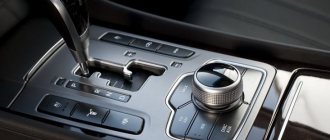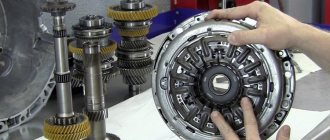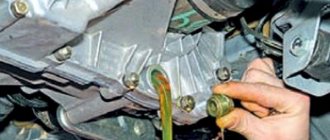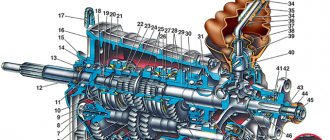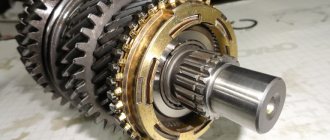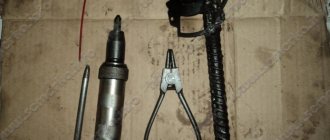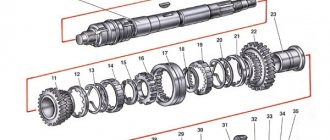A manual gearbox is a unit in which gear selection and engagement is carried out manually, mechanically. Due to the limited range of operation of vehicle engines, a transmission is used to expand the operating capabilities of the internal combustion engine and adapt to different driving conditions.
The main function of a manual transmission, like any other, is to adapt and transmit torque to the wheels by changing the gear ratio. In a manual transmission, this is done manually by selecting the appropriate gear for the situation. Torque in a manual transmission is carried out in stages.
The prototype for creating an automatic transmission was a manual transmission. Understanding the principle of its operation will give an understanding of the essence of the functioning of almost any transmission.
According to the number of steps there are:
- four-speed (mostly on old cars, now extremely rare);
- five-speed (most common);
- six-speed.
Types of manual transmission according to the number of available shafts:
- two-shaft (mainly installed on front-wheel drive passenger cars);
- three-shaft (installed on front-wheel drive and rear-wheel drive vehicles, both cars and trucks).
The robotic gearbox is a modern, improved manual transmission; gear shifting occurs using electrical mechanisms controlled by an electronic unit. Some modes in the “robot” are similar to automatic transmission modes, while others require selection of a mode. There is no clutch pedal.
Manual transmission device
A manual transmission consists of a clutch basket and the gearbox itself.
The power unit includes:
- crankcase (housing);
- primary, secondary and intermediate shafts;
- stage selection device;
- driven and driving sets of gears;
- synchronizers;
- bearings, couplings and seals.
All these components are located in the housing and interacting with each other transmit torque.
Clutch
The clutch is an integral component of a manual transmission, which disconnects the engine and gearbox at the moment of gear shifting without consequences for the units. To exaggerate, the clutch turns off the torque, while both the engine and the wheels of the car spin at idle.
The clutch is designed to neatly connect the motor and wheels. It consists of two disks, one of which is connected to the car’s motor, the second to the wheels of the vehicle. The transmission of torque is carried out through the input shaft of the transmission.
Peak development - robots
Electronics came to the rescue in the difficult task of improving the design of a manual transmission. With its help, they implemented control of gear shifting without driver participation. Such gearboxes are called robotic. Remaining structurally mechanical, and having in their device such a part as a friction clutch, they take on the process of squeezing and switching.
This device allows you to maintain the relative simplicity of the box itself and get closer to the control comfort of automatic transmissions. But having gotten rid of a number of manual transmission shortcomings, the new units acquired their own, unique to them.
Since the clutch mechanism has not gone away, a problem has arisen: when starting off on an incline, the car rolls back. This is due to the fact that when the driven and driven discs are opened, nothing holds the car - at this moment the driver moves his foot from the brake pedal to the accelerator. The problem can be solved in two ways - by making adjustments to the control algorithm, forcing the car to release pressure in the brake system with a delay, or by introducing a second clutch into the design. Then, when switching, one of them remains closed.
Operating principle and design of a two-shaft manual transmission
The essence of the operation of a manual transmission is to create connections between the primary and secondary shafts by varying gears with different numbers of teeth, which adapts the transmission to the constantly changing circumstances of the vehicle's movement.
For people ignorant of these issues, the essence of the functioning of a manual transmission can be explained in a simplified manner, in order to understand the essence of the issue.
This power unit provides the necessary operating modes of the engine by changing the number of revolutions, changing the transmitted force to the drive wheels. Accordingly, when the number of revolutions decreases, the transmitted force decreases, and when the number increases, it increases. This is necessary when maintaining the required engine operating mode when starting to move, reducing speed or accelerating.
The two-shaft manual transmission consists of:
- driving and driven shaft;
- gears of the drive and driven shafts;
- main gear;
- differential;
- synchronizers;
- gear shift mechanism;
- body - crankcase.
Most modern front-wheel drive cars are equipped with a two-shaft manual transmission.
In such transmissions, torque is transmitted from the input shaft gears to the driven gears. The drive shaft is connected to the motor through a flywheel, and the driven shaft transmits torque to the front wheels. They are located in parallel.
Without an intermediate shaft, typical of three-shaft manual transmissions, the dimensions of the unit are smaller, as is the weight, but the increased number of gears leads to a decrease in efficiency. The compact size of this transmission allows it to be installed on heavy motorcycles.
Principle of operation
A mechanical transmission is required to change the torque and transmit it from the internal combustion engine to the wheels. The torque coming from the engine is supplied to the input shaft of the box using the clutch pedal. Due to this, it is transformed by interconnected pairs of gears (steps) and transmitted directly to the wheels of the car.
All gear pairs have their own gear ratio, which is responsible for the number of revolutions and the supply of torque from the engine crankshaft to the wheels. An increase in torque by the transmission causes a decrease in crankshaft speed. When it decreases, it’s the other way around. Before changing gears in a manual transmission, you need to depress the clutch pedal, which interrupts the flow of power from the internal combustion engine. The vehicle always starts moving from gear 1 (except for trucks), and the subsequent increase in gear occurs gradually, with a sequential change of gearbox stages from low to high. The moment of switching is determined by the speed of the car and the indicators of the instruments: tachometer and speedometer.
Operating principle and design of a three-shaft manual transmission
The fundamental principle of the operation of a manual transmission is the gear interaction of gears, which are enveloped in transmission fluid located in the gearbox housing.
This manual transmission includes:
- driving and driven shafts;
- intermediate and additional shafts;
- frame;
- synchronizers;
- gear sets;
- gear switching mechanism with locks and locking mechanisms;
- gear shift lever.
Bearings located in the housing ensure rotation of the shafts. Each shaft has a set of gears with a different number of teeth.
The drive shaft is connected to the engine via a clutch basket, the driven shaft is connected to the cardan shaft, and the intermediate shaft transmits torque to the secondary shaft.
There is a drive gear on the input shaft, which spins the intermediate gear with a firmly fixed set of gears located on it. The driven shaft has its own set of gears moving along splines.
Between the gears of the secondary shaft there are synchronizer clutches, which equalize the angular speeds of the gears with the revolutions of the shaft itself. The synchronizers are firmly attached to the shafts and move longitudinally along splines. On modern manual transmissions, such clutches are located at each stage.
How do synchronizer clutches work?
Synchronizers are included in the circuits of modern manual transmissions. These devices are necessary to mutually smooth out the speed of rotation of the gears and ensure a smooth transition to another speed. Such clutches are not used in transmissions with an increased number of gears - boxes with a number of levels reaching up to 18 pieces are typical for special-purpose vehicles. Sports models also do not have synchronizers.
Synchronizer operation order:
- The clutch is fed to the corresponding gear when the gear is engaged.
- Direction of power flow to the locking ring.
- The interaction of the surfaces of the gear and conical coupling due to friction forces.
- Turn the locking ring all the way.
- Aligning the ring teeth in line with the coupling (to prevent mutual movement).
- Meshing of the teeth of the synchronizing clutch with the gear wheel (gear blocking).
The described process occurs within a fraction of a second.
How to use a manual transmission
Driving cars with a manual transmission and competent control of such vehicles has specific features, the knowledge of which is necessary for any driver.
How to start a car manually
Proper starting of a mechanical engine has a positive effect on its service life and ensures the safety of surrounding machines and people. To avoid causing interference, you must periodically drive away quickly.
Sequence of actions when starting the machine:
- depress the clutch pedal all the way and move the gearshift lever to the neutral position; if you have doubts whether the speed has been selected correctly, you need to move the lever handle to the sides; when the gearshift handle is in the neutral position, the lever moves freely to the right and left;
- when moving the car to neutral, it is necessary to secure the vehicle to avoid uncontrolled movement; to do this, the car is put on the handbrake or the brake pedal is depressed;
- When the clutch is depressed and the car is held with the brake, you need to turn the ignition key, the icons on the instrument panel should light up, as soon as almost all the icons go out, you should further turn the key and after starting the engine, release the key.
Experienced drivers and mechanics advise:
- turn the starter, that is, start the engine for no more than 10 seconds to avoid breakdowns; if the car does not start, turn the key back and after a minute the engine starting procedure is repeated;
- When starting in sub-zero temperatures, it is necessary to warm up the car for several minutes with the clutch pedal depressed to reduce the load on the engine and transmission due to the thickening of the oil from frost.
How to change speeds
The gear shift circuit for a manual transmission is most often located on the outer part of the lever handle.
The speed switching process consists of several stages:
- Press the clutch pedal all the way with your left foot;
- with your right hand, move the lever to the required position;
- Gently release the clutch pedal and slowly press the accelerator pedal.
Recommendations from seasoned drivers for extending the life of a manual transmission:
- Driving in direct gear (fourth on most gearboxes) will reduce fuel consumption;
- Reverse speed is selected only after the vehicle has completely stopped moving;
- the pedal must be pressed quickly and all the way, and released with a careful, measured movement, avoiding jerking;
- on a road with insufficient grip (ice, clay, wet surfaces), driving in neutral or with the clutch pedal depressed is contraindicated;
- when making a turn, it is not recommended to squeeze the clutch, even to change speed;
- When moving freely on the road, it is possible to effectively brake the engine by gradually lowering the steps.
Oil
Regularly checking the fluid level and replacing it according to the manufacturer's instructions will extend the life of the manual transmission.
In most mechanical transmissions, the working fluid is replaced at intervals of 50-60 thousand kilometers due to the accumulation of work by-products and a decrease in the properties of the oils.
New developments in the world of gearboxes
The current variety of gearboxes is not a frozen collection of metal, but one that absorbs everything new - the world of gearboxes. However, conventional boxes, which appeared simultaneously with the advent of the car, have the lowest rate of development, and robotic ones have the highest, while the latter cease to be ordinary modernized boxes, moving further and further away from them - full control of electronics and drives affects, and their design is already underway using its own special technology. That is, these boxes are, in fact, increasingly moving away from the mechanics that gave birth to them.
This can be seen in the results - the best robotic gearboxes from Ferrari provide gear changes in no more than 60 ms, and DSG gearboxes (Volkswagen) are capable of switching individual gears in 8 ms! Thanks to this, a Volkswagen Golf, for example, equipped with a 7-speed gearbox of this type, is approximately 20% more economical than the same car, but equipped with a traditional “mechanics”.
In recent years, the characteristics of lubrication systems have sharply improved - currently produced gearboxes are often equipped with a pressure lubrication system, and sometimes even shared with the engine. This solution makes it possible to dramatically increase the service life of the gearbox relative to the usual lubrication system due to the oil present in the engine crankcase, as well as to ensure the necessary cooling of the gearbox due to constant oil circulation. Today there are already quite a large number of manual transmissions, but they use ATF oil for their lubrication, that is, automatic transmission oil.
In conclusion, it is worth saying that the trend of our time is that the design of a manual transmission is becoming more and more complex in the pursuit of dynamics, speed, efficiency... What it will be like in the future is difficult to say, probably no one will say.
Pros and cons of a manual transmission
Advantages of manual transmission:
- it is possible to tow the car to any route distance, even with the engine turned off;
- it is possible to start the car from a pusher when the battery is discharged or there is a malfunction in the ignition system;
- smaller dimensions and weight than an automatic transmission;
- the dynamism of the vehicle, the ability to choose the driving style by appropriately changing the engine speed;
- it is possible to use to the maximum all the capabilities of the engine at the speeds regulated by the manufacturers at each speed, at which the torque is maximum or close to it;
- dynamic acceleration and fuel economy compared to an automatic (with aggressive and sporty driving styles, consumption increases);
- simplicity of design;
- reasonable price for maintenance and repairs, especially in comparison with automatic transmissions;
- great work resource.
The disadvantages of manual transmission include:
- the difficulty of driving cars with manual transmission, especially for beginners;
- clutch, which can be burned by inexperienced drivers or with regular slipping in snow and ice;
- due to inexperience, there is a possibility of damaging the transmission when switching to reverse gear when moving forward or operating the clutch incorrectly;
- reduced engine life due to too low or, conversely, high speeds, the automatic transmission will not allow this to happen;
- when switching gears is not fast enough and when switching at too low speeds, a significant loss of engine power occurs;
- increased fatigue due to the need to control the clutch, selecting and changing gears, especially for inexperienced drivers;
There are quite a lot of advantages of a manual transmission, and the disadvantages will disappear as you gain experience driving a manual transmission.
Advantages and disadvantages
Mechanical box
is not the only, but the most common type of gearbox. It has both obvious advantages and obvious disadvantages, of which there are still much fewer.
Repairing a gearbox is a rather complicated procedure and should only be entrusted to a specialist.
So, the advantages of manual transmission can be called:
- minimum cost and weight;
- good acceleration dynamics;
- simplicity and clarity of design;
- reliability;
- low cost of maintenance.
Manual gearbox
rigidly connects the power unit to the drive pair, which allows you to achieve maximum driving efficiency on icy conditions and in off-road conditions. In addition, the manual transmission can be completely decoupled from the engine, allowing the vehicle to be started using external force (towing, pushing) without restrictions.
But this system also has certain disadvantages, including:
- the need to constantly change gears, which is tiring when driving for a long time;
- long-term development of correct gear shifting skills;
- only step change of gear ratios;
- relatively low clutch resource.
For these reasons, today the mechanic's box
is the main, but not the only popular gear shift system.
Method of interaction and number of shafts
In modern gearboxes, two main methods of interaction between shafts are used - mechanical and hydraulic. Mechanical is used for CVT, manual transmission and AMT, hydraulic is intended for automatic transmission, as well as CVT.
Mechanical, in turn, is implemented by using:
- gear transmission, in the predominant number of cases based on bevel or cylindrical gears;
- planetary gear, includes such elements as a sun gear (it is simply called the sun), an epicycle (a large wheel called a crown), a lever mechanism (called a carrier, also known as a space fork) and gear wheels (also known as satellites);
- friction transmission, practically cannot be installed independently, only with planetary gears or gears.
The hydraulic type of shaft interaction in its pure form is very, very rare. In the majority of cases, we are talking about a hydromechanical scheme based on the installation of a fluid coupling or torque converter, as well as a planetary mechanical transmission.
The next important classification parameter is the number of shafts. The three most common schemes are:
- two-shaft;
- three-shaft;
- multi-shaft
And to complete the picture, the fourth is a shaftless manual transmission, a very rarely used solution.
The two-shaft scheme is based on the installation of two shafts, one primary (driver), the second secondary (driven). Classics of the genre.
The three-shaft scheme is more complicated. There are three shafts; in addition to the two mentioned above, there is also an intermediate one. In addition, such a scheme can be coaxial or non-coaxial (involves the installation of a transfer case).
The multi-shaft scheme corresponds to the two-shaft scheme, only there are several driven, and sometimes driving, shafts.
CVT design
CVT (CVT)
consists of three basic parts:
- clutch;
- broadcast;
- a mechanism for providing reverse gear, in most cases a planetary gearbox, but options are also possible.
The clutch differs in design; the most common is an automatic centrifugal, electromagnetic type with an ECU, multi-disc, usually with a “wet” sump. A number of manufacturers, without further ado, use a classic torque converter.
CVT transmission in the majority of cases is V-belt or V-chain (a pair of sliding pulleys plus a trapezoidal, wedge-shaped chain or belt), but there is also a toroidal transmission (a pair of coaxial shafts with a toroidal, spherical surface), which is much less common. For general development. There is such an option as magnetic and a number of other transmissions.
